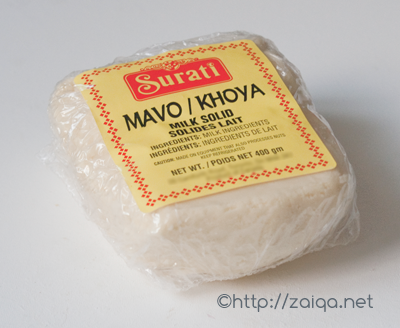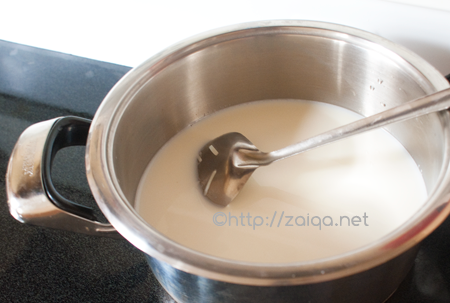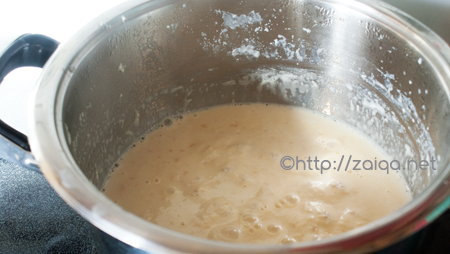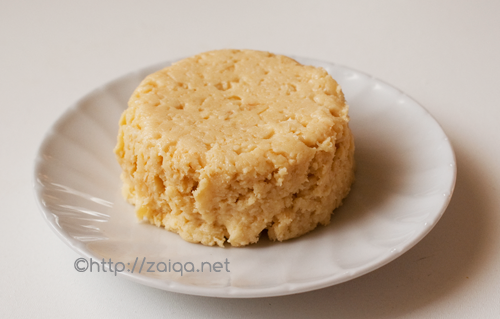Basic How To: Homemade Khoa/Mawa
Milk and its products like Yogurt, Ghee, Khoa, Paneer are much valued and used very extensively in Indian cooking.
Khoa (also referred to as Khoya/Khawa/Mawa) is reduced milk, reduced to such an extent that it is almost doughy or granular in texture. This concentrated solid is used as the base in most of the Indian sweet preperations like Burfi, Gulab Jamun, Peda, Kalakand, Chumchum, Kalajamun and various other Halwa’s and Mithai’s. It is very easily available in India and sold at the dairy stores or parlours by halwais(milk traders) selling all kinds of Indian diary products like ghee, paneer, curd etc. In Canada, I am lucky enough to find Khoa packets available ready made at most of the Indian stores or Bombay Bazaar.

store brought Khoa packet from Bombay bazaar in Toronto
I prepare two kinds of Khoa at home usually, the ‘Chikna khoa’, and the ‘Daan-e-daar khoa’.
Chikna Khoa: has about 80% mositure and is made by slowly cooking milk uncovered until it is reduced to a doughy mass.
Daan-e-daar Khoa (granular khoa): is made coagulating milk with acid and then slow cooked until all the moisture is evaporated and you are left with granular milk solids.
The rock hard kind of Khoa that you get ready made from the market which even can be grated is called as Batti Khoa.
Many friends and readers of my blog have asked me the procedure to prepare Khoa at home, or its substitutions. Here is a pictorial tutorial for the procedure to prepare Khoa at home:
Chikna Khoa
Makes – 170 gms
Pour 1 liter milk in a heavy bottomed milk saucepan (of you can use any clean heavy bottomed vessel, you can even use a heavy bottomed non-stick saucepan) at medium high and let it come to a boil once.

Lower the heat to medium and let cook until the milk is reduced to 1/4th the original quantity. This takes about 1 hour or so and it requires a careful watch to prevent milk from getting burnt, and a constant/very frequent stirring.

Once the milk is reduced to 1/4 quantity, lower the heat to medium low and let cook for some more time, stirring continously, until it is dry and lumpy/doughy.

Remove from heat and transfer the khoa to a cup and let cool. Once cool, refrigerate it for a hour so that it thickens/hardens. Remove the prepared Khoa from the refrigerator transfer to a zip-lock sandwich bag and freeze to store for future use, or use immediately. Normally one liter of milk should give you 125-170 gm of khoya.

fresh and home-made ~ Chikna Khoa
This procedure prepares unsweetened khoa. To prepare sweetened khoa, add desired quantity of sugar on the last stages to sweeten the khoa.
Daan-e-daar Khoa
Pour 1 liter milk in a heavy bottomed milk saucepan (of you can use any clean heavy bottomed vessel, you can even use a heavy bottomed non-stick saucepan) at medium high and let it come to a boil once. Add 1 tbsp lemon juice so that the milk curdles and lower the heat to medium and continue cooking. Keep stirring the milk and cook until most of the moisture has been evaporated and the milk is reduced to dry lumpy texture. Remove from heat and transfer the khoa to a cup and let cool. Once cool, refrigerate it for a hour so that it thickens/hardens. Remove the prepared Khoa from the refrigerator transfer to a zip-lock sandwich bag and freeze to store for future use, or use immediately.
Tip: Daan-e-dar khoa can also be prepared from failed yogurt.
A friend of mine had once shared this useful recipe for a quick khoa substitute:
Quick Khoa Substitutes:
1. Add full fat or low fat milk powder and just a little bit of full fat or low fat unsweetened condensed milk/heavy cream to make it into a semi-solid paste in a bowl. Pour this into into a thick milk saucepan at medium low heat. Let cook stirring continously until it is until it is dry and lumpy/doughy. Remove from heat and let it cool completely. Transfer to refrigerator so that it thickens/hardens. Shape/cut into blocks and store the khoa blocks in plastic wrap in zip-lock sandwich bags and freeze to store for future use, or use immediately.
2. If all this is not possible, you can simply substitute khoya with equal amounts of milk powder. That should work out fine.
This post is my contribution to the event Back to Basics originally stated by Jaya, and currently being hosted by Aqua at Served with Love.
Luv,
Mona